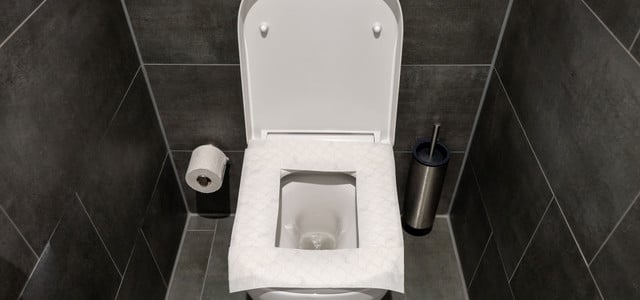
Just don’t go to the toilet with your bottom: Some people force themselves into an awkward squat in public toilets or put paper on the toilet seat. An expert reveals how useful all of this is.
Yuck! Some public toilets greet you with so much dirt and smell that you want to turn around as soon as you push open the cubicle door.
But the bladder and intestines are pushing so hard – what has to come out has to come out. So the strategy is: hold your breath and endure the disgust. By the way, it is completely normal for this feeling to occur when you see dirty toilets. “Mother Nature doesn’t want us humans to become infected with pathogens,” says Markus Egert, Professor of Microbiology and Hygiene at Furtwangen University. “That’s why we’re probably innately disgusted by two things – corpses and feces.”
Germs on the bottom don’t make you sick
But how big is the risk of catching a gastrointestinal infection in public toilets? According to the researcher, there are no studies on how many infections actually originate from visiting (public) toilets.
Of course, it is possible that we come across potentially pathogenic germs in toilets. For example, if a person who had norovirus previously sat on the toilet with diarrhea. With this pathogen, a comparatively small amount of virus is enough to cause infection.
But there is an important limitation. And that should give some people a little more peace of mind when putting on public toilet seats: “Whatever ends up on our thighs, pants or buttocks doesn’t make us sick. The germs have to get into our mouths for that to happen,” says Markus Egert.
What the danger is from his point of view: that we touch surfaces in public toilets that have fecal germs on them and then continue with our everyday lives without our hands having seen soap and water in the meantime.
Therefore, the most important tip of all is not surprising: Wash your hands after using the toilet. And thoroughly. This means: wet your hands, soap them thoroughly for 20 to 30 seconds, then rinse and dry completely, preferably with a disposable towel.
It is better not to line the toilet seat with paper
You can also ensure that as few germs as possible end up on your hands while going to the toilet. “The trick is to touch as little as possible,” says Markus Egert.
Now everyone who covers the toilet seat with toilet paper before sitting on it has to be strong. From the hygiene professor’s point of view, this makes little sense. “The more craft work I do in the cubicle, the more likely I am to touch things that I wouldn’t have otherwise touched,” says Egert. So you tend to mess with toilet paper and glasses more often – especially “when you sit down and everything slips – and then you have to jerk everything back into place.”
According to Egert, if you don’t want to touch the toilet seat with your buttocks, you can use the “ski squat” principle. This means crouching over the toilet so that your butt is floating over it. Well-trained thighs are an advantage here. And accuracy also counts: After all, the waste should actually end up in the toilet and not on the glasses – future toilet users will thank you.
Droplets in the room: Close the lid when washing up!
What else you can do for a more hygienic toilet experience: close the lid when flushing. This ensures that there are fewer droplets that can contain bacteria and viruses in the toilet cubicle – and thus also reduces the risk of infection.
Another tip that everyone probably follows intuitively in public toilets anyway: stay there for as short a time as possible. The longer you stay there, the more aerosols – these fine droplets – you breathe in. But Markus Egert can give the all-clear: “But I wouldn’t hold my breath either.”
** marked with ** or orange underlined Links to sources of supply are partly partner links: If you buy here, you are actively supporting Techzle\.com, because we then receive a small part of the sales proceeds. More info.